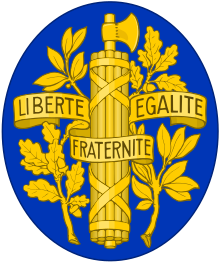1945 French constitutional referendum
A constitutional referendum was held in France on 21 October 1945.[1] Voters were asked whether they approved of the Assembly elected on the same day serving as a Constituent Assembly, and whether until a new constitution was approved, the country would be governed according to a proposed set of laws that appeared on the ballot paper. If the first proposal had not been approved, the Third Republic would have been restored, but its approval led to the creation of the Fourth Republic. Both were approved by wide margins with a turnout of 79.8%.[2]
| This article is part of a series on the |
| Politics of France |
|---|
 |
|
|
|
Related topics
|
Results
Question I
Do you agree that the assembly now elected will serve as a constituent assembly?
| Choice | Metropolitan France | Total | |||
|---|---|---|---|---|---|
| Votes | % | Votes | % | ||
| For | 17,957,868 | 96.4 | 18,584,746 | 96.4 | |
| Against | 670,672 | 3.6 | 699,136 | 3.6 | |
| Invalid/blank votes | 1,025,744 | – | 1,070,103 | – | |
| Total | 19,654,284 | 100 | 20,353,985 | 100 | |
| Source: Nohlen & Stöver | |||||
Question II
Do you agree that until the enforcement of a new Constitution, public affairs will be organised according to the proposal of the law which you find reproduced on the rear of the ballot?
| Choice | Metropolitan France | Total | |||
|---|---|---|---|---|---|
| Votes | % | Votes | % | ||
| For | 12,317,882 | 66.5 | 12,794,943 | 66.5 | |
| Against | 6,217,512 | 33.5 | 6,449,206 | 33.5 | |
| Invalid/blank votes | 1,064,890 | – | 1,109,836 | – | |
| Total | 19,645,284 | 100 | 20,353,985 | 100 | |
| Source: Nohlen & Stöver | |||||
References
- Dieter Nohlen & Philip Stöver (2010) Elections in Europe: A data handbook, p674 ISBN 978-3-8329-5609-7
- Nohlen & Stöver, p684